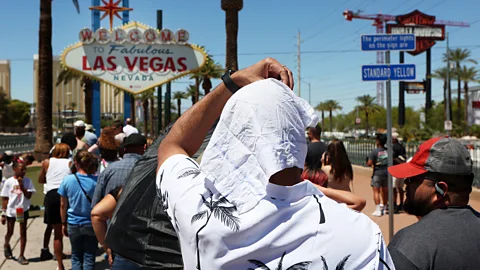Life in a heat dome: The American West is figuring out how to keep cool
 Getty Images
Getty ImagesFrom planting trees to painting streets white, US cities are fighting extreme heat.
In 2013, Los Angeles became the first large city to a law requiring all new homes to have a cool roof. Since then, the city – where the number of days at 35C (95F) is expected to soar by 2050 – has rolled out numerous other keep-cool initiatives, including painting pavements white and expanding its Green Standards Building Code to include cool roofs on non-residential buildings and retrofits.
Despite the mitigation efforts, however, the population is still suffering from issues linked to excess heat. A study found the number of extreme heat-related emergency calls in Los Angeles between 2018 and 2022 directly correlated with the number of days that were 32C (90F) and above.
"The opportunities for heat mitigation in the US are huge," says Steffen Lehmann, director of the University of Nevada's Urban Futures Lab. "The knowledge is there, but the things that need to be done are not being done. It is extremely frustrating."
In June, an ongoing heat dome brought dangerous temperatures to the western US. Residents have experienced temperatures of up to 46.1C (115F) in California, Nevada, Utah and Arizona. The National Weather Service (NWS) warned temperature records would be "tied or broken" with "little to no overnight relief from the heat".
This latest heatwave is making it even more vital for cities to ready themselves for hot weather. But some experts say that cities are inadequately prepared – even though the science behind how to cool cities down is well known.
 Getty Images
Getty ImagesAround 80% of America's population lives in urban areas – where the heat island effect can drastically worsen the impact of hot weather. Urban heat islands are densely populated, built up areas with few trees and large areas of dark concrete and asphalt that absorb the sun's energy. As the sun goes down, the manmade materials release the stored heat – ensuring that the city stays hot, even at night. Urban heat island temperatures can be up to 11C (20F) hotter than less populated areas.
Vulnerable communities, such as the elderly, children, and low-income populations, are disproportionately impacted by the heat – with hotter temperatures even taking a toll on newborn babies.
As US cities continue to experience record-breaking, life-threatening triple-digit days, researchers like Lehmann say many areas are still underprepared. In 2022, a group of scientists examined 175 municipal city plans from the 50 most populous cities in the US. Although the majority mentioned heat, "few included" strategies to address it, the report found.
"If cities are not painting a complete picture of heat — how chronic it is, and its disparate impacts on the ground — we're not going to be able to fully protect residents, and we could end up exacerbating existing social and environmental injustices," says co-author Emma French, a doctoral student in urban planning at University College of Los Angeles.
